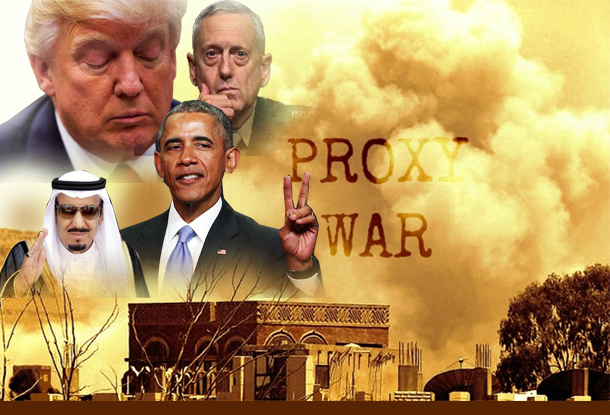
Nicolas J S Davies
Consortium News
Seventy-seven million people in North and South Korea find themselves directly in the line of fire from the threat of a Second Korean War. The rest of the world is recoiling in horror from the scale of civilian casualties such a war would cause and the unthinkable prospect that either side might actually use nuclear weapons.
Since the first Korean War killed at least 20 percent of North Korea’s population and left the country in ruins, the U.S. has repeatedly failed to follow through on diplomacy to establish a lasting peace in Korea and has instead kept reverting to illegal and terrifying threats of war. Most significantly, the U.S. has waged a relentless propaganda campaign to discount North Korea’s legitimate defense concerns as it confronts the threat of a U.S. war machine that has only grown more dangerous since the last time it destroyed North Korea.
The North has lived under this threat for 65 years and has watched Iraq and Libya destroyed after they gave up their nuclear weapons programs. When North Korea discovered a U.S. plan for a Second Korean War on South Korea’s military computer network in September 2016, its leaders quite rationally concluded that a viable nuclear deterrent is the only way to guarantee their country’s safety.
What does it say about the role the U.S. is playing in the world that the only way North Korea’s leaders believe they can keep their own people safe is to develop weapons that could kill millions of Americans?
The Changing Face of War
The Second World War was the deadliest war ever fought, with at least 75 million people killed, about five times as many as in the First World War. When the slaughter ended in 1945, world leaders signed the United Nations Charter to try to ensure that that scale of mass killing and destruction would never happen again. The U.N. Charter is still in force, and it explicitly prohibits the threat or use of military force by any nation.
It was not just the scale of the slaughter that shocked the world’s leaders into that brief moment of sanity in 1945. It was also the identities of the dead. Two-thirds of the people killed in the Second World War were civilians, a drastic change from the First World War, only a few decades earlier, when an estimated 86 percent of the people killed were uniformed combatants. The use of nuclear weapons by the United States raised the specter that future wars could kill an exponentially greater numbers of civilians, or even end human civilization altogether.
War had become “total war,” no longer fought only on battlefields between soldiers, but between entire societies with ordinary people, their homes and their lives now on the front line. In the Second World War:
–Fleets of warplanes deliberately bombed cities to “dehouse” civilian populations, as British officials described their own bombing of Germany. “As I write this,” George Orwell wrote from London in 1941, “Highly civilized human beings are flying overhead, trying to kill me.”
–Submarines sank hundreds of merchant ships in an effort to starve their enemies into submission. General Carter Clarke, who was in charge of interpreting Japanese intelligence for President Truman, said in a 1959 interview that Japan surrendered because it faced mass starvation due to the sinking of its merchant shipping, not because of the gratuitous U.S. nuclear attacks on Hiroshima and Nagasaki. It was estimated that 7 million more civilians would die of starvation if Japan fought on until 1946.
–Genocidal mass extermination campaigns killed civilians based only on their political affiliation or ethnicity. Under cross-examination by a young American prosecutor, Benjamin Ferencz, SS Gruppenfuhrer Dr. Otto Ohlendorf explained patiently to a courtroom in Nuremberg why he found it necessary for the “preemptive defense” of Germany to order the killing of hundreds of thousands of civilians. He explained that even children had to be killed to prevent them too becoming enemies of Germany when they grew up and found out what happened to their parents.
Despite the U.N. Charter and international efforts to prevent war, people in countries afflicted by war today still face the kind of total war that horrified world leaders in 1945. The main victims of total war in our “modern” world have been civilians in countries far removed from the safe havens of power and privilege where their fates are debated and decided: Yugoslavia; Afghanistan; Iraq; Somalia; Pakistan; Yemen; Libya; Syria; Ukraine. There has been no legal or political accountability for the mass destruction of their cities, their homes or their lives. Total war has not been prevented, or even punished, just externalized.
But thanks to billions of dollars invested in military propaganda and public relations and the corrupt nature of for-profit media systems, citizens of the countries responsible for the killing of millions of their fellow human beings live in near-total ignorance of the mass killing carried out in their name in these “red zones” around the world.
People in ever-spreading war zones are living under the very conditions of total war that the world recoiled from at the end of the Second World War. Like Orwell in London in 1941, they hear highly civilized human beings flying overhead trying to kill them, human beings who know nothing about them beyond the name of the city where they live and its strategic value in wars that offer them, the victims, nothing but death or destitution.
In the case of drones, the human beings trying to kill them from the other side of the world are so highly civilized that they can hop into cars and drive home to have dinner with their families at the end of their shifts, while another “team member” efficiently takes over the “joy-stick” and carries on killing.
People in Yemen, Syria, Iraq and Libya have been subjected to hunger and starvation under sieges and naval blockades that are as brutally effective as German and American submarines were in World War Two. Millions of people in Yemen face an imminent danger of starvation under the U.S.-backed naval blockade and Saudi and Emirati bombing of Yemeni ports.
In retaliation for one missile fired at Riyadh, the Saudi capital, last week, the U.S.-backed coalition completely closed all Yemen’s ports, tightening the blockade on millions of starving people. The requirements of necessity and proportionality, which have been basic principles of customary international law since the Nineteenth Century, lie buried in the graveyards of Iraq and Afghanistan.
Continue this article at Consortium News…
READ MORE WAR ON TERROR NEWS AT: 21st Century Wire War on Terror Files
SUPPORT 21WIRE – SUBSCRIBE & BECOME A MEMBER @ 21WIRE.TV















